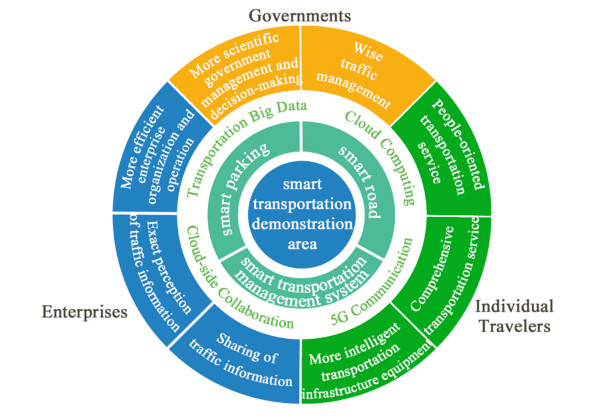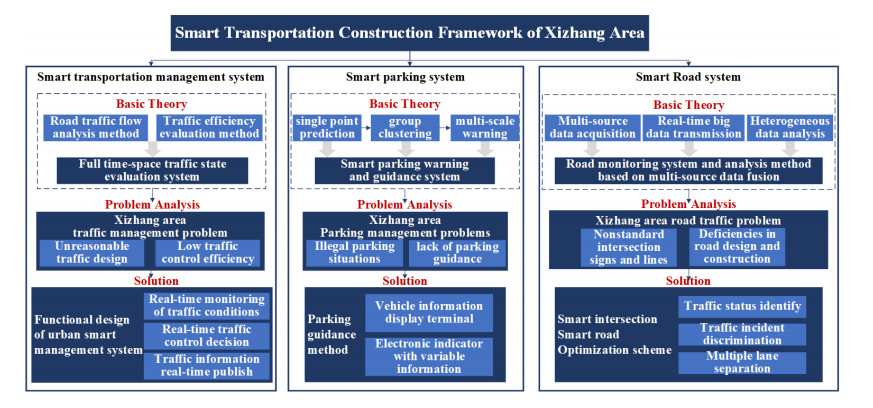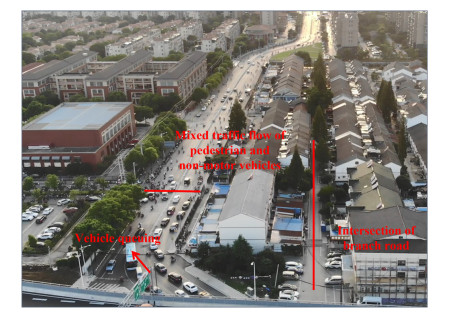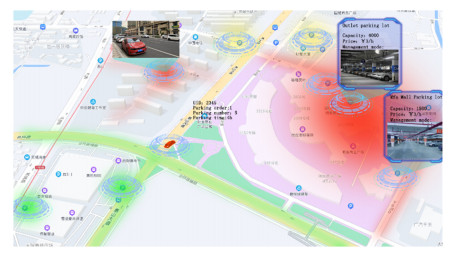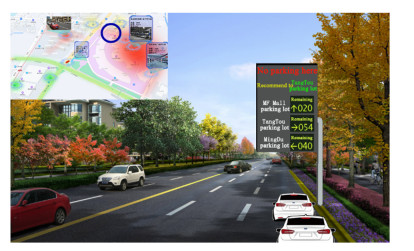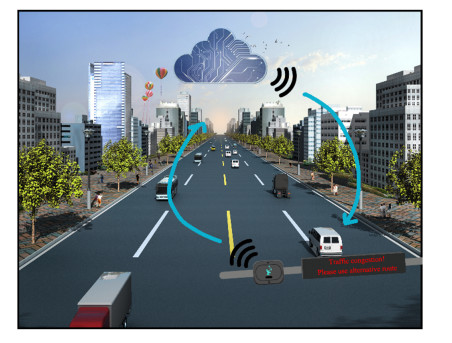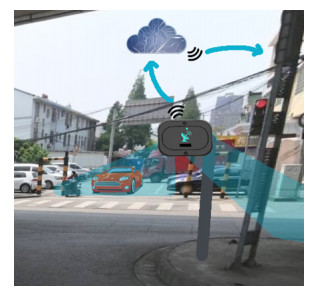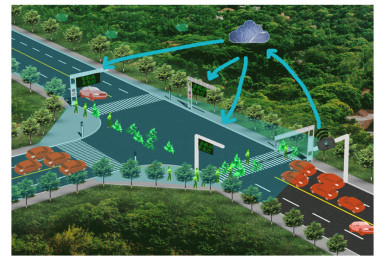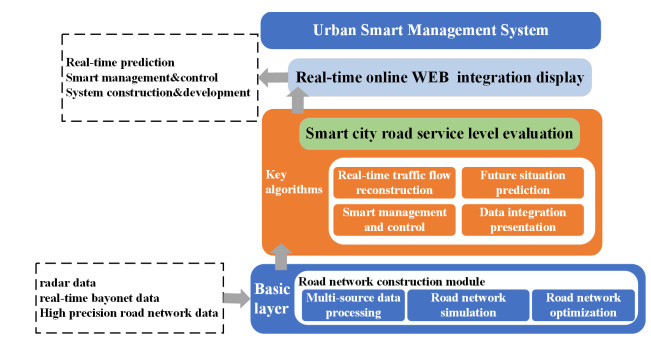1.
Introduction
1.1. Smart transportation
Smart transportation mainly relies on big data from mobile Internet and Internet-of-Things (IoT) technologies, providing answers to four typical questions: who, where, when and what they have done [1]. Thus, these systems can precisely track individual characteristics and activity patterns of travelers. Using machine learning and other artificial intelligence (AI) technologies, smart transportation can mine and analyze big data on transportation, portray a depiction of individual trips, realize comprehensive data integration in the transportation field and support traffic planning and management [2,3,4,5].
Since the start of the 21st century, governments worldwide have been progressively promoting research and application transformation systems from intelligent transportation to smart transportation. In recent years, a series of innovative technologies, such as big data, cloud computing, IoT and mobile communication, have pushed intelligent transportation systems to the new development stage of smart transportation [6,7,8,9,10,11,12]. Studies have shown that smart transportation was first proposed in developed countries. For example, the United States formulated a two-stage development strategy: The first stage helped realize the goal of building a multi-mode transportation system nationwide in 2014, emphasizing vehicle, infrastructure and passenger interconnection and vehicle-vehicle interconnection; the second stage focuses on the construction goal of the full life-cycle development of smart transportation, emphasizing emerging technologies, network security, data access and exchange and autonomous driving [13,14]. Since 2013, Japan has focused on developing autonomous driving and the Internet-of-Vehicles (IOV) to realize a highly informed traffic system. Furthermore, in 2019, Japan issued the ITS Handbook, outlining a strategic plan and development trends for autonomous driving and vehicular collaboration. This plan includes using the ETC2.0 technology application for smart roads [15]. In 2020, to realize smart travel, Europe published a sustainable and intelligent transportation strategy for promoting the development of vehicle navigation, smart parking, carsharing and driving assistance [16,17,18].
Smart transportation systems are widely accepted by many local governments in China, and several key technologies have been applied in many cities. For instance, Hangzhou created an urban brain in 2016 by integrating big data, cloud computing, machine learning and other innovative methods.
These technologies can significantly improve traffic control and the quality of service [19,20]. In 2018, Beijing established a smart traffic management system for subcenters. The aim is to offer refined and smart traffic management methods [21]. In 2019, Shanghai constructed a smart traffic management system empowered by smart public security, thus enabling governance approaches for several transportation-related departments, including police, management and construction [22,23].
In addition, to promote the development of smart transportation, transportation network companies (TNCs) have developed information system platforms such as the urban brain system proposed by Alibaba, Tencent and Huawei [24]. A typical example is the Apollo program launched by Baidu, which provides solutions for intelligent transportation, autonomous driving and autonomous vehicles [25]. Smart transportation products and system functions offer many advantages for developing transportation systems. More comprehensive applications, wider monitoring areas, more precise supervision, quicker construction and more effective management are all benefits of these new technologies. However, there are still several issues with the top-level design, including standard specifications and system designs [26].
1.2. Key applications
This study focuses on studying smart parking, smart roads and smart management systems to address the problems caused by smart transportation development. This study builds a systematic framework of smart transportation and realizes an organic combination of these three aspects.
Communication technologies allow smart parking systems to collect, manage and analyze massive amounts of data on parking spaces in real time. In a smart parking system, high-quality services are provided, including mobile terminal searches, suggestions, reservations and navigation [27]. Therefore, smart parking offers multiple benefits, such as increasing the rate at which available parking spaces are utilized, optimizing parking service levels, reducing instances of unlawful parking and resolving parking issues in metropolitan areas [28]. A smart parking system is the key link of an intelligent transportation system, and IoT is at the core of its development [29].
A smart road collects and analyzes transportation data using roadside devices, such as radar, cameras and smart street lighting, and it monitors traffic flow and road hazards in real time. Hence, a smart road can be considered a combination of smart pavements, smart intersections and smart road perception systems that can perceive all objects. Through the processing and publishing of transportation information, a smart road can realize road operation status perception, traffic guidance, vehicle tracking, flow warning, pedestrian warning and rapid emergency response. Finally, it provides important support for emerging vehicle-road cooperation.
Smart transportation management systems promote urban transportation management and control technology applications that rely on artificial intelligence methods and fully integrate information, communication and software technologies. The aim is to enhance the traditional method of supply-side management to meet travel demand, improve the quality of service and adopt intelligent methods to fulfill a supply and demand balance to eventually accomplish the goals of ensuring safety, improving efficiency, perfecting the environment and saving energy.
1.3. Challenges and contributions
Table 1 summarizes the current status of smart transportation literature. We found that few studies have fully considered all three research areas and propose a framework for a smart transportation construction system. Therefore, to develop an entire ecosystem, in this study, we present the concept of a systematic smart transportation framework that results in the construction of three fields.
Although artificial intelligence technology has been applied in some typical scenarios in the field of transportation engineering, it still faces huge technical challenges, mainly reflected in the current technological level of artificial intelligence. It is still difficult to meet the needs of smart transportation development. The reliability of a smart transportation system needs to be verified. The regulations and standards of intelligent transportation systems still need to be established and improved.
This paper aims to solve a series of traffic problems in the Xizhang area by considering smart parking, smart roads and smart transportation management systems in a framework. The main contributions of the paper are as follows.
1) This paper proposes a new concept for a smart transportation systematic framework that relies on artificial intelligence methods, and it realizes the organic integration of smart parking, smart roads and smart transportation management systems.
2) The smart parking system proposed in this paper uses the multiscale parking warning technology to realize the multiscale parking warning, parking management and control and parking guidance in the Xizhang area. The smart road system can use radar-vision fusion machines to obtain the real-time traffic flow status and predict parking demand, parking duration and the number of empty parking spaces.
3) The smart transportation management system combines smart parking and road systems. It can predict road congestion situations based on the analysis of massive transportation datasets and achieve smart parking control based on multiscale parking warnings.
The paper is structured as follows. Section 2 introduces the design of the framework for smart transportation. In Section 3, the problem statement and sub-system applications are presented. Section 4 includes remarks on our work. Section 5 concludes our work.
2.
Design of the framework for smart transportation
This study proposes a new concept for a smart transportation systematic framework, as shown in Figure 1, to achieve an organic integration of smart parking, smart roads and smart transportation management systems. A full-range transport ecosystem will be established to improve the quality of travel services in urban areas, based on new technologies, including transportation big data, cloud computing, cloud-side collaboration and 5G communication. The goal of systematic smart transportation framework construction is to create a new pattern of regional smart transportation development. It primarily provides services to governments, enterprises and individual travelers. The following eight aspects are among the primary functions: more scientific government management and decision making, wiser traffic management, people-oriented transportation services, comprehensive transportation services, more intelligent transportation infrastructure equipment, sharing of traffic information, accurate perception of traffic information and more effective enterprise organization and operation.
The systematic smart transportation framework is focused on parking, roads and transportation management system scenarios. To build this systematic framework, three essential procedures must be followed: (ⅰ) It is important to develop data-sharing platforms and industry standards. They play an important role in developing big data transportation platforms and standard designs, which cover the entire smart transportation system. (ⅱ) It is necessary to improve the smart perception ability of transportation networks. The realization of all-object perception is the primary goal, including applying roadside perception equipment for smart intersections, smart road facilities and other all-object perceptions. In addition, realizing full time-space perception is required, which includes the state of people, complex traffic flows, parking demand and environmental information. Moreover, based on full-granularity video acquisition and wide-area radar detection, lighting and vision can be integrated. Then, a smart transportation management system based on transportation analysis of the entire space-time road network is established. (ⅲ) By relying on important support from smart parking and road systems, smart transportation management systems are enriched.
2.1. Smart parking system
Multi-scale parking warnings, which serve as the basis for smart parking systems, are based on single-point prediction and a group clustering algorithm [51,52]. When conducting smart parking management, two basic algorithms for regional parking situation analysis are parking situation analysis and the prediction for a single parking space. Analyzing the historical parking time series data of parking space data is the first stage in implementing smart parking. To estimate the mass parking situation, it is necessary to first construct a short-term prediction of the occupancy rate of a single parking spot before expanding the scope to include all parking spaces in an area. Based on the parking occupancy prediction results, the second step is to integrate the spatial location of the parking space for three-dimensional spatial clustering. The last step involves conducting a multilevel parking warning from the viewpoint of the point-parking space, line-road and network area based on the prediction results regarding the parking situation by single-point prediction and spatial clustering. Areas with a prominent contradiction between parking space supply and demand can be identified, warnings of unusual happenings can be provided, and the rapid calculation of parking guidance can be realized.
2.2. Smart roads in urban areas
It is important to promote smart road construction in urban areas and adopt radar vision fusion machines. Compared with video flow detectors and lidar, a radar-vision fusion machine has the advantages of all-weather, wide-coverage, high-precision, multi-function and low-cost applications. The main operational process includes collecting data, sending information to an edge cloud platform, conducting fusion computing, commanding decisions and sending decisions back to the front-end display device. Finally, it can realize the functions of smart transportation timing and guidance [53].
2.3. Smart transportation management system
Based on machine learning methods and big data transportation technologies, we can accurately predict the traffic flow of a road network and then conduct transportation management [54,55]. The main methods are to realize the encapsulation of an automatic large-scale complex road network based on GIS, OSM and XML. Important tasks are attaching rich traffic attributes, including road speed limitations, length and grade information, identifying the transportation operation status of each area of the road network in grid form and evaluating road network traffic efficiency.
3.
Problem statement and sub-system applications
The Xizhang area is an import subcenter of Wuxi City located at the junction of the Huishan District and the Xishan District. This area was selected for the case study because of its high travel demand and intricate traffic management. Current transportation management measures face many difficulties in providing wide-range, high-precision, low-latency and quick-response transportation services. Considering the problem of increasing travel demand, a systematic transportation framework must be established for the Xizhang area. This can fully realize smart parking, roads and transportation management system applications, as shown in Figure 2.
3.1. Problem statement
3.1.1. Parking problems
The development of the Xizhang area is limited by a series of parking problems, including serious illegal parking, randomly occupied road resources and inefficient operations. The main reasons for this are scarce land resources and insufficient parking space. At present, parking guidance in the surrounding area and even the entire Xizhang area relies on traditional static road signs and simple electronic signs. This can only realize guidance in the direction dimension but does not take into account the relationship between the supply and demand of parking spaces because of a lack of smart parking guidance. Recent data show that the Xizhang area has approximately 3400 parking spaces. However, the demand for parking spaces on a special working day is about 3300, on weekends it is over 5000, and on a special day with large events occurring it is 7000. Hence, it is evident that the number of parking spaces can only meet the demand on working days.
3.1.2. Road and intersection problem
There are many abnormal intersections in the Xizhang area, such as the Tianyi Road-Fengxiang Road intersection, as shown in Figure 3. Tianyi Road is the main road to the Tianyi Primary School. However, no railings separate the entrance and exit of the parking space for this school. Pedestrians and non-motor vehicles must cross the street, which further leads to a queue of vehicles on Tianyi Road. Because vehicles waiting at the west exit road cannot pass quickly, the problem of traffic congestion is further increased at this intersection. In addition, there is only one straight line at the western entrance of the intersection. This easily leads to a long queue of vehicles and leads to more serious road congestion. In addition, entering and leaving vehicles from branch roads significantly affect the passage of vehicles at intersections.
3.1.3. Transportation management system problem
With the rapid development of road networks in the Xizhang area, traffic demand and infrastructure construction have increased. It is important to build a smart transportation management system for addressing these increasing traffic problems. At present, two major problems exist. First, current traffic monitoring methods are outdated. Current technologies rely only on cameras for monitoring, which are unable to collect real-time traffic flow information and cannot help ease traffic congestion quickly. Additionally, standard text alarm information can only represent simple facts and has a restricted range of expressions. Hence, a smart transportation management system is required for traffic flow monitoring, congestion identification and emergency handling. Second, information- and data-dispersion problems exist. There are many applications and multisource transportation information in current transportation management systems, including mobile phone signaling data, video data and bayonet data. Consequently, it is challenging to make accurate decisions.
3.2. Solution methods
3.2.1. Smart parking application
A smart parking system can identify areas with demand and supply imbalance problems using multiscale parking warning technology. Then, early warning information on unusual stations, streets and regions of parking spaces is provided, which results in rapid deduction and parking guidance for vehicles.
To achieve smart parking, three important methods must be followed. First, we build a smart IoT for a front-end device. The parking space detector based on the principle of geomagnetic induction is used for collection. The parking space detector is installed at the entrance and exit. The obtained parking data is transmitted to the control center through 5th Generation Mobile Communication Technology. The main aim is to make a single-point prediction for parking demand, parking duration and vacant parking spaces, based on integrating the total factor information of front-end perception and the control equipment in various parking lots, information on real-time parking demand, number of parking spaces, parking times, parking duration and other key indicators. Second, group clustering is conducted based on the location and occupancy rate, which identifies areas with a prominent contradiction between parking space supply and demand. It provides parking guidance information to users via mobile and vehicle-mounted information-display terminals. Parking-related information includes parking searches and recommendations, parking reservations, integrated parking navigation and indoor navigation. Finally, variable electronic information signage was adopted for displaying real-time information on parking spaces for parking guidance.
This smart parking system can realize the following functions to address the parking problem in the Xizhang area.
1) Multiscale parking warning: There is a huge parking space demand in the Xizhang area, but the utilization rate of each parking space is low because of weak information sharing. Hence, it is necessary to realize multiscale warnings of points, lines and planes. We consider the parking lots of outlets as points, roads such as Tianyi Road and North Ring Road as lines and the Xizhang area around the outlets as the plane. As shown in Figure 4, a shortage in the parking space supply at stations, in-road illegal parking problems and supply and demand imbalance problems in the region are identified. Then, the smart parking system can identify key areas with serious demand and supply imbalances, provide data support for smart parking guidance and conduct exact parking management.
2) Parking management and control: Based on the results of the multi-scale parking warning and identification, the smart parking system can identify real-time in-road parking and illegal parking problems and then perform parking management and control, as shown in Figure 5. First, single-point prediction for in-road parking analyzes roads with major in-road parking issues and electronic signage to indicate places with serious in-road parking. Smart parking control was then implemented to inform about locations with serious in-road parking. Second, to address the issue of illegal parking, we should use a spatial clustering method for identifying high-probability areas, installing an electronic sign that forbids it and then guiding traffic to low-demand parking spots. These single-point prediction results can be transmitted to a smart parking control center in real time. In this way, the traffic management department can deal with illegal parking and reduce the impact of illegal parking.
3) Parking guidance: A smart parking system can guide cars to recommended parking spaces in areas with significant supply and demand imbalance issues. This system is based on the results of single-point prediction, variable electronic signage setup and real-time and predicted information of empty parking spaces, ultimately generating the optimal recommendation scheme. As shown in Figures 6 and 7, multi-level smart parking guidance can optimize the utilization rate of each parking space of outlets, reduce the time users spend searching for empty parking spaces and finally address the parking difficulty problem in the outlet area.
3.2.2. Smart road application
In this scheme, radar-vision fusion machines are placed at intersections in the Xizhang area. The main methods used are obtaining the real-time traffic flow status and predicting parking demand, parking duration and the number of empty parking spaces. Furthermore, roadside parking space data and parking station information data are collected, which are gathered using flow detection sensors and parking detectors based on the principle of geomagnetic guidance. Figure 8 shows a smart road construction of Tianyi Road based on radar vision fusion machines.
The smart road system serves smart intersection and smart road scenarios.
1) Variable electronic signage is installed at the exit and entrance of the parking station at Tianyi Primary School. Based on the detection results of the radar-vision fusion machine, real-time control information is sent to the display device via an edge cloud platform, which displays the motor vehicle priority or non-motor vehicle priority, as shown in Figure 9.
2) Smart road systems can control the signal timing at intersections in real time for different traffic flow scenarios. When the detection result of a radar-vision fusion machine indicates that the traffic flow on the main road at an intersection is large, the edge cloud platform adjusts the signal timing according to the real-time traffic demand. Then, it appropriately increases the red-light duration of the branch road to improve traffic efficiency. As shown in Figures 10 and 11, when the detection results indicate that the traffic flow on the main road at an intersection is small, the edge cloud platform must adjust the signal timing and appropriately reduce the red-light duration of the branch road to improve traffic efficiency.
3.2.3. Smart transportation management application
A smart transportation management system combines smart parking and road systems, as shown in Figure 12. It has the functions of real-time prediction for road congestion and multi-scale parking warnings based on multi-source heterogeneous transportation big data. Different from the traditional intelligent transportation system, the system proposed in this paper is supported by the collected multi-source traffic big data and information at all levels of the city, and it performs the real-time calculations. This requires high data quality and algorithm design which is more advanced than existing systems.
A smart transportation management system can predict road congestion situations based on the analysis of massive transportation datasets. Such a system can comprehensively understand the perception of the human-vehicle-road-environment and provide rich traffic index data. By integrating traffic data of the road network and information on congestion caused by traffic accidents, intersection deadlocks, traffic overflow, traffic accidents and other unusual items and then adopting information on danger points and accident points reported by travelers, it can accurately discover the source of congestion and predict an evolution trend for unusual congestion. Furthermore, the system will recommend reasonable travel routes for the public after determining the degree of road congestion by analyzing the road traffic situation, average speed and congestion miles.
A smart transportation management system can achieve smart parking control based on multiscale parking warnings. It integrates parking space resources in a city through edge computing, AI algorithms, intelligent maps and time-space big data technologies. First, it conducts a single-point prediction of the parking demand, parking duration, empty parking spaces and parking space information in the station and roadside, and it then combines this with the spatial location to create three-dimensional spatial clustering. Finally, it extends this model to the entire parking space in the region to make mass parking situation predictions, aiming to provide convenient and efficient operation and comprehensive supervision of city-level parking problem solutions. Hence, a smart transportation management system can improve the intelligence level of parking resources and enhance the quality of parking services.
4.
Remark
The smart transportation system of Xizhang provides a rich experience for the construction of a safe, green and smart systematic transportation framework. It builds a smart parking system based on multiscale parking warnings, a smart road system in an urban area based on multisource data fusion and a smart transportation management system based on real-time big data. It also integrates smart parking and road systems into a smart transportation management system, thereby contributing to building an integrated transportation ecosystem. The proposed framework has strong practicability and extendibility, which can be divided into several subsystems. For new application scenarios, it is easy to build corresponding intelligent transportation systems by inputting corresponding data.
Single-point prediction and group clustering are the core of smart parking system construction. Emerging technologies for edge computing, AI algorithms, AI maps and spatiotemporal big data provide technical support for smart parking systems. A prediction for the near future is that a map of smart parking data can be constructed through the integration of various parking resources in a city. Optimal solutions for parking space resource allocation can be obtained.
With radar-vision fusion machine applications and the support of smart transportation management systems, a smart road can provide information collected with the characteristics of the whole object, full time and space and full size of holographic awareness. In a smart road system, information and sensor technologies can provide a high-speed and reliable communication network, which can ensure the future integration of cloud-edge-end smart road collaborative management. Moreover, these technologies will provide support for building a highly data-sharing smart-road system.
In the future, smart transportation management systems can bridge the gap between government administration and new technologies and then promote transportation big data sharing. A series of innovative AI technologies, including 5G, cloud computing and machine learning, can realize scientific, standardized and refined transportation management. Proactive, accurate and timely information publishing can improve the utilization rate of urban transportation big data and increase the traffic capacity of roads.
5.
Conclusions
This paper reviews the development status of smart transportation system construction and identifies three research directions: smart parking, smart roads and smart transportation management systems. The aim is to overcome the drawbacks of the current development of transportation systems. The application scenarios and key technologies of the three application directions are highlighted, and a case study is presented based on current transportation problems in the Xizhang area.
Studies have shown that a series of traffic problems exist in the Xizhang area, which can be addressed by adopting a smart transportation system. These problems, such as parking space demand and supply imbalance, illegal parking situations, unreasonable road and intersection designs and low levels of service, hinder rapid and smooth transportation operations. Moreover, the following issues also affect transportation planning and management: superfluous transportation equipment, outdated traffic flow monitoring technologies and scattered multi-source heterogeneous data. Hence, given the existing problems, including parking difficulties, traffic congestion and outdated management technologies in the Xizhang area, a framework for smart transportation construction based on smart parking, roads and transportation management systems in urban areas is proposed in this study. This can improve the level of transportation services in the Xizhang area.
Herein, a research framework is proposed for smart transportation systems, but theoretical research should be expanded in future studies. Here are the limitations. This paper has not considered the challenges and difficulties of emerging technological applications in the Xizhang area. How to combine innovative technologies and equipment has not been adequately addressed in this study. In addition, it cannot guarantee the optimality of the proposed framework, so demonstration applications should be carried out around Tianyi Road to verify the practicability of a smart systematic transportation framework. More analyses before and after case applications should be conducted as a next step.
Acknowledgments
This research was financially supported by the Southeast University Start-up Grant (No. 1149007001), Beijing-Shanghai Expressway Law Enforcement Supervision Research (No. 8549003016) and Multi-mode Road Impedance Function Research (No. 6849008016).
Conflict of interest
The authors declare that there is no conflict of interest.









 DownLoad:
DownLoad:
